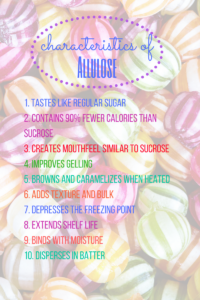As manufacturers look towards reformulating to reduce sugar in sweetened products to align with the latest U.S. Department of Agriculture (USDA) Dietary Guidelines recommendations for sugar intake, some are looking to allulose as a sweetener.
What is allulose?
Allulose, also known as D-psicose, is an epimer of fructose with the same molecular formula as glucose and fructose. What sets allulose apart from a typical sugar substitute is its negligible caloric value of approximately 0.2kcal/g compared to 4kcal/g of table sugar (sucrose). Additionally, it is not metabolized by the body and has no impact on blood glucose.
What is its source? 
As a naturally occurring substance, allulose can be found in small quantities in jackfruit, figs, raisins and other sources. Because allulose is a rare sugar, harvesting from natural sources would not be feasible to meet the demands of the food industry. Commercially produced allulose is developed through biological production under optimal pH (7.5 to 9.0) and temperature (40-60˚ C) conditions for successful enzymatic conversion of fructose to allulose in mass quantities.
What are its characteristics?
With a taste profile at 70% the sweetness of sucrose, it is comparable in texture and bulk, making it well-suited for low calorie substitution. Since allulose is not as sweet as sucrose, larger quantities are needed to achieve the same level of sweetness. Alternatively, allulose can be used when combining sweeteners, such as sucralose or stevia, to achieve the desired sweetness and mouthfeel sweetener properties without adding calories.
Research has found that allulose is highly soluble (Fukada et al. 2010), can improve gelling in certain food products (Sun and Hayakawa 2004), and browns like sugar when heated, achieving desired textures and appearances in various applications. Addition of allulose also depresses the product’s freezing point, which makes it useful for frozen desserts.
What applications are approved for use?
Allulose is generally recognized as safe (GRAS) for all ages by the US Food and Drug Administration (FDA). It is recognized for use as a flavor modifier in various food and beverage applications including: low or reduced calorie bakery products, alcoholic beverages, soft drinks, fruit juice and fruit flavored drinks, yogurt, frozen dairy desserts, hard and soft candies, chocolate, chewing gum, coffee mix, sauce, fat-based creams, nutrition bars, meal replacement shakes, medical foods, and sugar substitutes.
With such versatility, it’s no surprise that allulose has the potential to make major waves in the food industry as a non-nutritive sweetener.
Fukada K, Ishii T, Tanaka K, Yamaji M, Yamaoka Y, Kobashi K, Izumori K (2010) Crystal structure, solubility, and mutarotation of the rare monosaccharide D-psicose. Bull Chem Soc Jpn 83:1193–1197.
Sun Y, Hayakawa S, Izumori K (2004) Antioxidative activity and gelling rheological properties of dried egg white glycated with a rare keto-hexose through the Maillard reaction. J Food Sci 69:C427–C434.